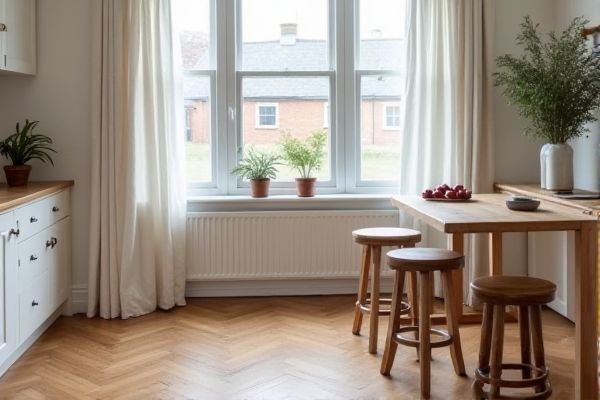
Backless stools offer minimal support and promote active sitting, ideal for compact spaces and quick use, while full-back stools provide enhanced comfort and lumbar support suited for prolonged seating. Explore the rest of the article to discover which stool best fits your needs and preferences.
Table of Comparison
| Feature | Backless Stools | Full-Back Stools |
|---|---|---|
| Design | Minimalistic, compact | Supportive, larger footprint |
| Comfort | Less support, may cause fatigue | Enhanced lumbar and upper back support |
| Space Efficiency | Ideal for small spaces | Requires more room |
| Use Case | Short-term seating, bars, counters | Longer seating, offices, dining |
| Price Range | Generally more affordable | Typically higher cost |
| Mobility | Easy to move and store | Heavier, less portable |
| Posture Support | Limited support, encourages active sitting | Supports upright posture |
Introduction to Stool Types: Backless vs Full-Back
Backless stools offer a minimalist design that maximizes space and allows for easy movement, making them ideal for compact areas or casual seating. Full-back stools provide enhanced comfort and support with extended backrests, promoting better posture for prolonged use. Choosing between these stool types depends on your space constraints, comfort preferences, and intended seating duration.
Key Design Differences Explained
Backless stools feature a minimalist frame without any back support, emphasizing compactness and ease of movement, ideal for casual or small spaces. Full-back stools provide robust lumbar support with a continuous backrest, enhancing comfort for prolonged seating in dining or bar settings. The key design differences revolve around ergonomics and spatial efficiency, where backless stools prioritize flexibility, while full-back stools focus on posture and extended use comfort.
Ergonomics: Comfort and Posture Comparison
Backless stools promote active sitting by encouraging better posture and core muscle engagement due to the lack of back support, making them ideal for short-term use or dynamic work environments. Full-back stools offer enhanced comfort and lumbar support, reducing fatigue during extended sitting sessions by maintaining spinal alignment, which benefits individuals with back issues or those requiring prolonged seating. Your choice between backless and full-back stools should consider ergonomic needs, duration of use, and the level of postural support necessary for optimal comfort and spine health.
Space and Versatility Considerations
Backless stools save valuable floor space, making them ideal for smaller areas or tight kitchen islands where maximizing room is crucial. Their versatile design allows for easy movement and storage under counters, enhancing your space efficiency without sacrificing seating capacity. Full-back stools, while bulkier, provide more comfort and support but require additional space, making them better suited for larger dining areas or home bars with generous room layouts.
Aesthetic Appeal and Decor Matching
Backless stools offer a sleek, minimalistic aesthetic that seamlessly blends into modern or compact spaces, enhancing openness and visual flow. Full-back stools provide a more substantial presence, complementing traditional or formal decor styles by adding structure and comfort. Choosing between them depends on the desired balance between streamlined elegance and supportive design in your interior.
Practicality for Different Settings
Backless stools offer flexible seating and easy maneuverability, making them ideal for casual settings like home bars or kitchen islands where space is limited. Full-back stools provide enhanced comfort and support, suitable for longer seating periods in dining rooms or office environments. Choosing between the two depends on balancing space constraints and ergonomic needs for the specific setting.
Durability and Material Options
Backless stools often feature simpler designs with metal or wood frames, making them durable yet lightweight and easy to move, while full-back stools typically incorporate additional support structures that may include upholstered surfaces and reinforced frames for enhanced sturdiness. Material options for backless stools lean toward minimalist wood, metal, or plastic, offering easy maintenance, whereas full-back stools can utilize a broader variety of materials such as leather, fabric, and memory foam padding, increasing comfort but sometimes requiring more care. Choosing between the two affects your seating longevity based on use frequency and material resilience, with full-back stools usually providing greater overall durability due to their construction.
Cost and Value Analysis
Backless stools generally cost less than full-back stools due to simpler design and fewer materials, making them a budget-friendly option for minimalistic spaces. Full-back stools provide increased comfort and support, which can justify the higher price for long-term use in offices or dining areas. Evaluating durability, ergonomic benefits, and user preferences helps determine the overall value beyond initial cost differences.
Ideal Use Cases for Each Stool Type
Backless stools excel in compact spaces such as kitchen islands and bars where ease of movement and casual seating are essential, offering unobstructed legroom and a minimalist aesthetic. Full-back stools provide superior support and comfort, making them ideal for extended seating in dining rooms or workspaces where users benefit from ergonomic posture. Choosing between backless and full-back stools depends on space constraints, duration of use, and the desired balance between functionality and comfort.
Choosing the Right Stool for Your Needs
Backless stools offer a sleek, space-saving design ideal for compact areas or casual seating, promoting better posture by encouraging active sitting. Full-back stools provide enhanced comfort and support, making them suitable for longer periods of use and reducing strain on your back. Consider your seating duration and available space when selecting between backless and full-back stools to find the best fit for your needs.
 homyna.com
homyna.com